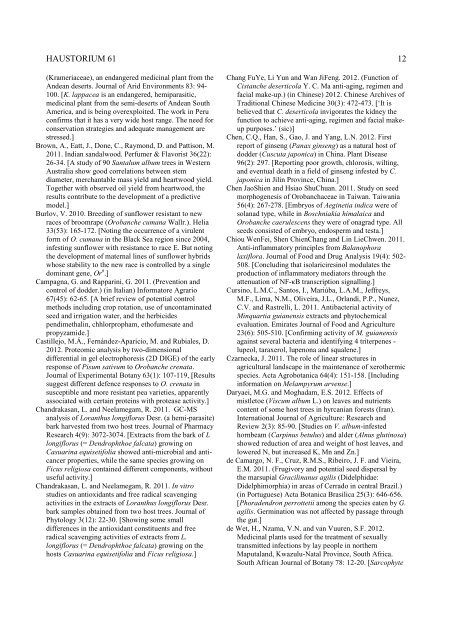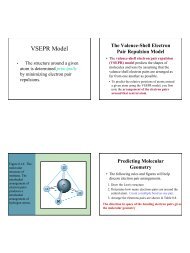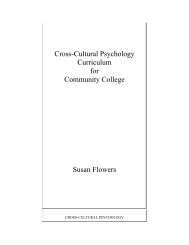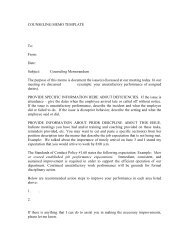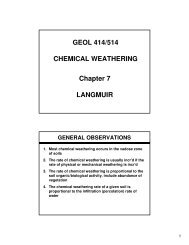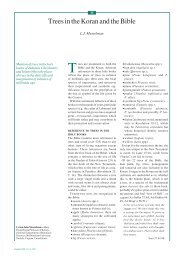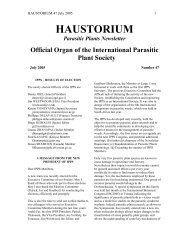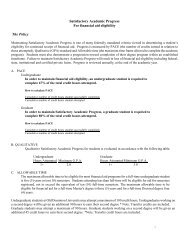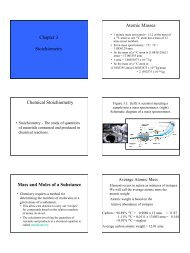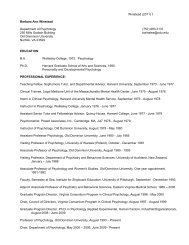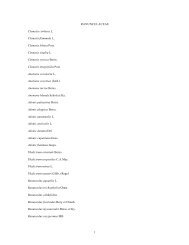HAUSTORIUM
HAUSTORIUM
HAUSTORIUM
Create successful ePaper yourself
Turn your PDF publications into a flip-book with our unique Google optimized e-Paper software.
<strong>HAUSTORIUM</strong> 61 12<br />
(Krameriaceae), an endangered medicinal plant from the<br />
Andean deserts. Journal of Arid Environments 83: 94-<br />
100. [K. lappacea is an endangered, hemiparasitic,<br />
medicinal plant from the semi-deserts of Andean South<br />
America, and is being overexploited. The work in Peru<br />
confirms that it has a very wide host range. The need for<br />
conservation strategies and adequate management are<br />
stressed.]<br />
Brown, A., Eatt, J., Done, C., Raymond, D. and Pattison, M.<br />
2011. Indian sandalwood. Perfumer & Flavorist 36(22):<br />
26-34. [A study of 90 Santalum album trees in Western<br />
Australia show good correlations between stem<br />
diameter, merchantable mass yield and heartwood yield.<br />
Together with observed oil yield from heartwood, the<br />
results contribute to the development of a predictive<br />
model.]<br />
Burlov, V. 2010. Breeding of sunflower resistant to new<br />
races of broomrape (Orobanche cumana Wallr.). Helia<br />
33(53): 165-172. [Noting the occurrence of a virulent<br />
form of O. cumana in the Black Sea region since 2004,<br />
infesting sunflower with resistance to race E. But noting<br />
the development of maternal lines of sunflower hybrids<br />
whose stability to the new race is controlled by a single<br />
dominant gene, Or 6 .]<br />
Campagna, G. and Rapparini, G. 2011. (Prevention and<br />
control of dodder.) (in Italian) Informatore Agrario<br />
67(45): 62-65. [A brief review of potential control<br />
methods including crop rotation, use of uncontaminated<br />
seed and irrigation water, and the herbicides<br />
pendimethalin, chhlorpropham, ethofumesate and<br />
propyzamide.]<br />
Castillejo, M.Á., Fernández-Aparicio, M. and Rubiales, D.<br />
2012. Proteomic analysis by two-dimensional<br />
differential in gel electrophoresis (2D DIGE) of the early<br />
response of Pisum sativum to Orobanche crenata.<br />
Journal of Experimental Botany 63(1): 107-119, [Results<br />
suggest different defence responses to O. crenata in<br />
susceptible and more resistant pea varieties, apparently<br />
associated with certain proteins with protease activity.]<br />
Chandrakasan, L. and Neelamegam, R. 2011. GC-MS<br />
analysis of Loranthus longiflorus Desr. (a hemi-parasite)<br />
bark harvested from two host trees. Journal of Pharmacy<br />
Research 4(9): 3072-3074. [Extracts from the bark of L<br />
longiflorus (= Dendrophthoe falcata) growing on<br />
Casuarina equisetifolia showed anti-microbial and anticancer<br />
properties, while the same species growing on<br />
Ficus religiosa contained different components, without<br />
useful activity.]<br />
Chandrakasan, L. and Neelamegam, R. 2011. In vitro<br />
studies on antioxidants and free radical scavenging<br />
activities in the extracts of Loranthus longiflorus Desr.<br />
bark samples obtained from two host trees. Journal of<br />
Phytology 3(12): 22-30. [Showing some small<br />
differences in the antioxidant constituents and free<br />
radical scavenging activities of extracts from L.<br />
longiflorus (= Dendrophthoe falcata) growing on the<br />
hosts Casuarina equisetifolia and Ficus religiosa.]<br />
Chang FuYe, Li Yun and Wan JiFeng. 2012. (Function of<br />
Cistanche deserticola Y. C. Ma anti-aging, regimen and<br />
facial make-up.) (in Chinese) 2012. Chinese Archives of<br />
Traditional Chinese Medicine 30(3): 472-473. [‘It is<br />
believed that C. deserticola invigorates the kidney the<br />
function to achieve anti-aging, regimen and facial makeup<br />
purposes.’ (sic)]<br />
Chen, C.Q., Han, S., Gao, J. and Yang, L.N. 2012. First<br />
report of ginseng (Panax ginseng) as a natural host of<br />
dodder (Cuscuta japonica) in China. Plant Disease<br />
96(2): 297. [Reporting poor growth, chlorosis, wilting,<br />
and eventual death in a field of ginseng infested by C.<br />
japonica in Jilin Province, China.]<br />
Chen JaoShien and Hsiao ShuChuan. 2011. Study on seed<br />
morphogenesis of Orobanchaceae in Taiwan. Taiwania<br />
56(4): 267-278. [Embryos of Aeginetia indica were of<br />
solanad type, while in Boschniakia himalaica and<br />
Orobanche caerulescens they were of onagrad type. All<br />
seeds consisted of embryo, endosperm and testa.]<br />
Chiou WenFei, Shen ChienChang and Lin LieChwen. 2011.<br />
Anti-inflammatory principles from Balanophora<br />
laxiflora. Journal of Food and Drug Analysis 19(4): 502-<br />
508. [Concluding that isolariciresinol modulates the<br />
production of inflammatory mediators through the<br />
attenuation of NF-κB transcription signalling.]<br />
Cursino, L.M.C., Santos, I., Mariúba, L.A.M., Jeffreys,<br />
M.F., Lima, N.M., Oliveira, J.L., Orlandi, P.P., Nunez,<br />
C.V. and Rastrelli, L. 2011. Antibacterial activity of<br />
Minquartia guianensis extracts and phytochemical<br />
evaluation. Emirates Journal of Food and Agriculture<br />
23(6): 505-510. [Confirming activity of M. guianensis<br />
against several bacteria and identifying 4 triterpenes -<br />
lupeol, taraxerol, lupenona and squalene.]<br />
Czarnecka, J. 2011. The role of linear structures in<br />
agricultural landscape in the maintenance of xerothermic<br />
species. Acta Agrobotanica 64(4): 151-158. [Including<br />
information on Melampyrum arvense.]<br />
Daryaei, M.G. and Moghadam, E.S. 2012. Effects of<br />
mistletoe (Viscum album L.) on leaves and nutrients<br />
content of some host trees in hyrcanian forests (Iran).<br />
International Journal of Agriculture: Research and<br />
Review 2(3): 85-90. [Studies on V. album-infested<br />
hornbeam (Carpinus betulus) and alder (Alnus glutinosa)<br />
showed reduction of area and weight of host leaves, and<br />
lowered N, but increased K, Mn and Zn.]<br />
de Camargo, N. F., Cruz, R.M.S., Ribeiro, J. F. and Vieira,<br />
E.M. 2011. (Frugivory and potential seed dispersal by<br />
the marsupial Gracilinanus agilis (Didelphidae:<br />
Didelphimorphia) in areas of Cerrado in central Brazil.)<br />
(in Portuguese) Acta Botanica Brasilica 25(3): 646-656.<br />
[Phoradendron perrottetii among the species eaten by G.<br />
agilis. Germination was not affected by passage through<br />
the gut.]<br />
de Wet, H., Nzama, V.N. and van Vuuren, S.F. 2012.<br />
Medicinal plants used for the treatment of sexually<br />
transmitted infections by lay people in northern<br />
Maputaland, Kwazulu-Natal Province, South Africa.<br />
South African Journal of Botany 78: 12-20. [Sarcophyte


